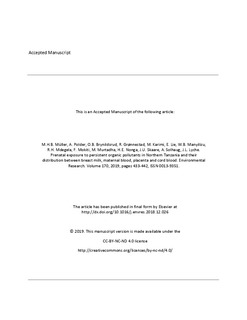Prenatal exposure to persistent organic pollutants in Northern Tanzania and their distribution between breast milk, maternal blood, placenta and cord blood
Müller, Mette Helen Bjørge; Polder, Anuschka; Brynhildsrud, Ola Brønstad; Grønnestad, Randi; Karimi, Mahin; Lie, Elisabeth; Manyilizu, Wilbert Bunini; Mdegela, R. H.; Mokiti, Frida; Murtada, M.; Nonga, Hezron Emmanuel; Skaare, J. U.; Solhaug, Anita; Lyche, Jan Ludvig
Peer reviewed, Journal article
Accepted version
Permanent lenke
http://hdl.handle.net/11250/2629047Utgivelsesdato
2019Metadata
Vis full innførselSamlinger
Sammendrag
Human exposure to persistent organic pollutants (POPs) begins during pregnancy and may cause adverse health effects in the fetus or later in life. The present study aimed to assess prenatal POPs exposure to Tanzanian infants and evaluate the distribution of POPs between breast milk, maternal blood, placenta and cord blood. For assessment of prenatal exposure, 48 maternal blood samples from Mount Meru Regional Referral Hospital (MMRRH), Arusha Tanzania, were analyzed for organochlorine pesticides (OCPs), polychlorinated biphenyls (PCBs), brominated flame retardants (BFRs), dioxin-like (DL) activity and perfluorinated alkyl substances (PFASs). For evaluation of POPs distribution between maternal/infant compartments, breast milk, placenta and cord blood corresponding to the maternal blood were analyzed for OCPs, PCBs and BFRs. In maternal blood, p,p´- DDE was detected in 100% of the samples ranging between 29 and 1890 ng/g lipid weight (lw). PCB-153 was the only PCB detected in maternal blood, with detection rate of 29% and concentrations up to 116 ng/g lw. BDE-47 was detected in 65% of the maternal blood samples, ranging between
